 the Travel Enthusiast
the Travel Enthusiast
- 02 Sep
tibi60 in Amazing Places | NO COMMENTSSanssouci – probably the most beautiful palace in Europe
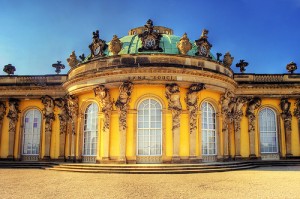 When it comes to architecture, it’s next to impossible to designate a building as the most beautiful/ugliest, because like all art, architecture is mostly subjective. But if you ask me, I have quite a firm opinion on the subject of Europe’s most beautiful palace.
When it comes to architecture, it’s next to impossible to designate a building as the most beautiful/ugliest, because like all art, architecture is mostly subjective. But if you ask me, I have quite a firm opinion on the subject of Europe’s most beautiful palace.Without question, Sanssouci is one of the most impressive Rococo buildings in the continent. Sure, it might be dwarfed by the Baroque opulence of Versailles, but Sanssouci has so many little hidden corners and delightful follies that it’s impossible not to fall in love with it.
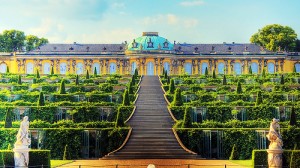 Sanssouci’s name couldn’t possibly be more fitting: it means “without a care” in French, and it’s enough to take one look at the palace to realize that it could make anyone’s worries disappear. It used to be the summer residence of Frederick the Great, the King of Prussia, where he would go to escape the intrigues and machinations of the Berlin Court.
Sanssouci’s name couldn’t possibly be more fitting: it means “without a care” in French, and it’s enough to take one look at the palace to realize that it could make anyone’s worries disappear. It used to be the summer residence of Frederick the Great, the King of Prussia, where he would go to escape the intrigues and machinations of the Berlin Court.As a matter of fact, Sanssouci is more of a pleasure villa than a palace, as it has only 10 rooms. The palace is located in the middle of a dream-like park, and its architectural style cannot be categorized as pure Rococo, but rather Frederician Rococo, as the king left his personal touch on almost every aspect of the palace. Frederick loved Sanssouci so much that he said that the place would die together with him. Fortunately, it didn’t, and it became the favourite residence of the royal family well into the 20th century.
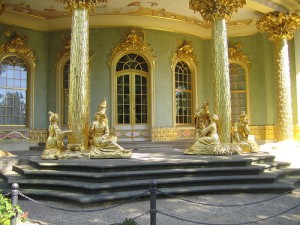 The palace is single-story with two side wings and a central bow topped with a dome, under which the name of the palace is written in gilded letters. The front of the palace acing the garden is decorated with caryatids, two for every window.
The palace is single-story with two side wings and a central bow topped with a dome, under which the name of the palace is written in gilded letters. The front of the palace acing the garden is decorated with caryatids, two for every window.The caryatids represent Bacchants of both sexes, worshippers of Bacchus, the god of wine (Frederick used to call the palace “mein Weinberghäuschen”, his little vineyard house). Frederick the Great was a recluse at heart, and Sanssouci was his hideaway. His descendant, Frederick William IV, renovated the palace, enlarged the side wings and turned it into a fashionable country house.
After his modifications, the west wing was known as the Ladies’ Wing, where the ladies in waiting would reside; his predecessor Frederick the Great wanted Sanssouci to be sans femmes as well, and no ladies were ever invited to the palace.
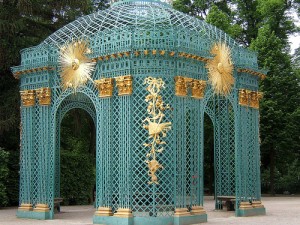 The interior of the palace is quite a sight: the outside colonnade continued into the Entrance Hall, carvings of Bacchus and wine themed images everywhere, gilded stucco. The Mable Hall was the main reception room, decorated with Carrara Marble, carvings, stucco and gilded ornaments, plus statues of Apollo and Venus.
The interior of the palace is quite a sight: the outside colonnade continued into the Entrance Hall, carvings of Bacchus and wine themed images everywhere, gilded stucco. The Mable Hall was the main reception room, decorated with Carrara Marble, carvings, stucco and gilded ornaments, plus statues of Apollo and Venus.The Dining Room is full of exquisite paintings by French artists, and this room is probably the most quintessentially Rococo of all the palace. The library seems to have been designed for the private use of the king, as it can be accessed only through a narrow stairway from the bedroom. The library is one of the most intimate places in the palace, with a peaceful atmosphere created by the paneled walls, alcoved bookcases and golden rocailles.
- Flights
- Hotels
- Packages
- Cars
- Cruises
travel search by Travelgrove (get this widget)
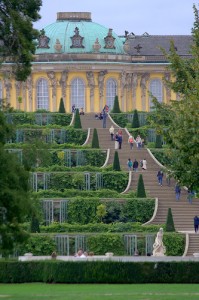 The terraced gardens and the park are just as visit-worthy as the palace itself. The gardens are replete with representations of Pomona and Flora, the Roman goddesses of gardens and vegetation.
The terraced gardens and the park are just as visit-worthy as the palace itself. The gardens are replete with representations of Pomona and Flora, the Roman goddesses of gardens and vegetation. The Rococo statuaries, obelisks, temples and follies help create a fairy-tale like atmosphere throughout the park. It’s not difficult to see why Frederick the Great loved Sanssouci so much. Who wouldn’t like to live in an earthly paradise like this?
You might also like

